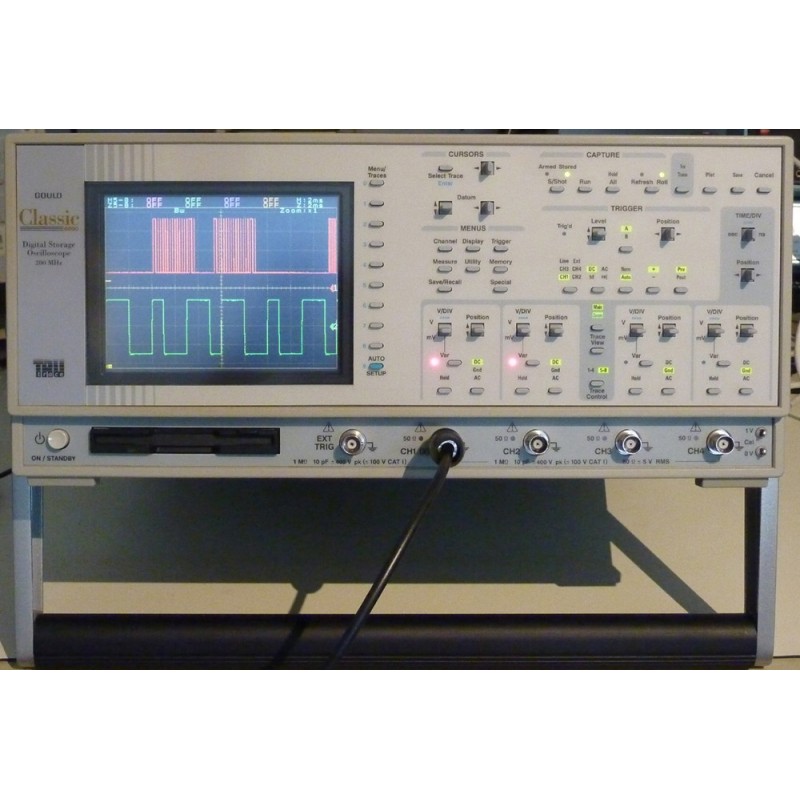
















Classic 6000
Incorporating TruTrace - a patented data compression technique - Classic 6000 offers fine, analog like waveform detail with the power and flexibility of a digital storage oscilloscope. Analyzing noisy signals, complex waveforms, transients, TV lines - Classic 6000 takes them all in its stride.
Key Features & Options
TruTrace® Analog Display
Advanced Triggering
Puls width Triggering
FFT
8 bit resolution
200 MHz Bandwidth
5 GS/s Sample Rate
50k Memory
Full Color Display
4 Low Noise Input Channels
200,000 Words-per-channel
Disks and RAM Mass Storage
Live Waveform Processing
Internal Thermal Plotter
Extensive Measurements and Analysis
User Defined Test Sequences
Programmable, IEEE-488.2 and RS-423
An important new feature of the Classic 6000 is TruTrace®, a patented compression technique which generates a variable-intensity display similar to that produced by an analog real-time oscilloscope. TruTrace allows fine details to be seen that would normally be lost using standard DSO display techniques, and is particularly useful for viewing complex transients and signals in the presence of noise.
Up to eight traces at a time can be viewed, so that 'live' traces from each of the four channels can be compared with reference traces or with zoomed versions. Channel annotation and ground markers are color matched to the traces to which they refer.
Color trace markers and annotations make it easy to distinguish between traces on the display. Note simultaneous FFTs on Traces 5 and 6.
The 200 MHz bandwidth is complemented by a sample rate of 100 MS/s. Basic, segmentable memory size is 50 k per channel with a 200 k option. Segments are automatically filled one after another on successive triggers.
A powerful DSP chip makes trace processing very rapid, particularly display update rate for complex analysis functions such as Fast Fourier Transform (FFT). The carefully planned arrangement of controls makes it very easy to use.
High resolution FFT shows harmonic detail due to frequency modulation of Triangle wave.
A new display ASIC is used to enhance the presentation of waveforms, and improve resolution for examining fine detail.
Classic 6000 can be upgraded with a wide range of internal and external options, including mass storage, plotters for hard-copy output, and interfaces for linking to hard disks, printers or computers.
Acquired or derived traces can be transferred to a PC easily via Gould's Transition 2 software package which supports I/O through either IEEE-488.2 or RS-423. Transition 2 provides a convenient link between a Classic 6000 and application programs, or analysis programs such as Gould's View II and ProView.
The Secrets of TruTrace
The TruTrace system used in the Gould Classic 6000 DSO is a patented data-compression technique which operates on each successive single-shot acquisition separately. It applies just as well to a single acquisition as to a series of repeated ones.
Above. Conventional DSO signal with no signal visible within TV frames. Below. Same signal using TruTrace on Classic 6000 clearly showing differences in amplitude.
The output of TruTrace's data-compression process is a reconstructed waveform in which each dot-joined element comprises a number of line segments of different intensities, rather than a single maximum/minimum line at constant intensity. The overall effect is similar to the variable-intensity display of an analog real-time oscilloscope.
One of the key benefits of TruTrace is the ability to display waveform details which cannot be seen on other digital storage oscilloscopes. A good example is the detail within video lines which have been compressed by using a slow timebase to view several lines at once. A long store would be able to capture the fine details, but the use of traditional data-compression methods would mean that most of the detail within each line would be lost by the time the trace was displayed. As a result, a typical digital storage oscilloscope will display a group of TV lines as solid bright blocks separated by a small synchronization time.
Unlike other display techniques which have recently been developed for use with repetitive signals, TruTrace deals equally well with transients and repetitive signals. It can also handle very long acquisition records.
Includes 50 k memory, color display, FFT and pulse width triggering as standard!